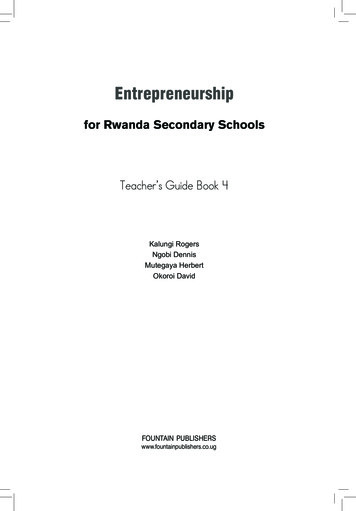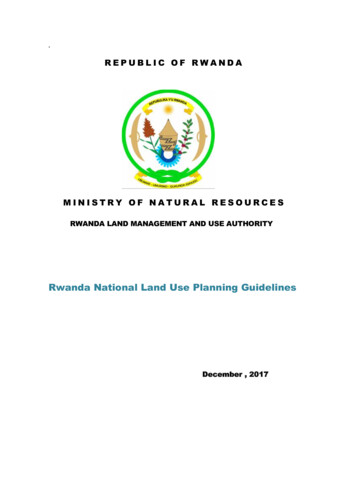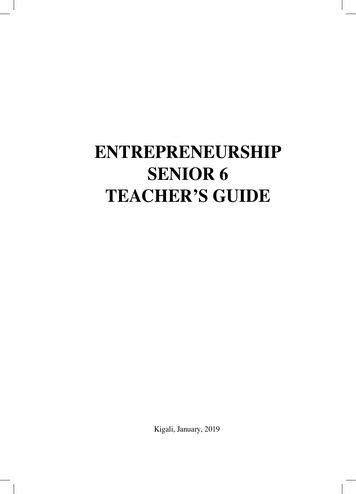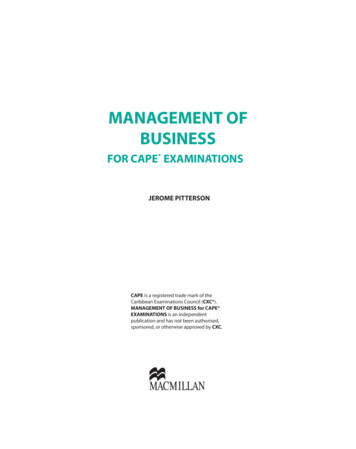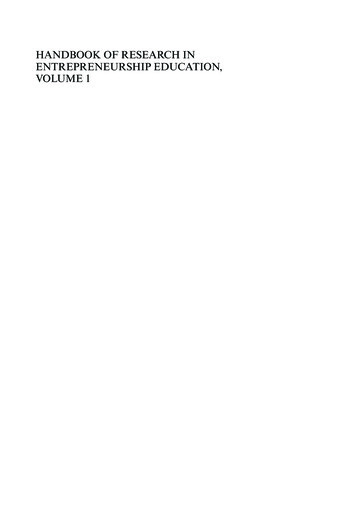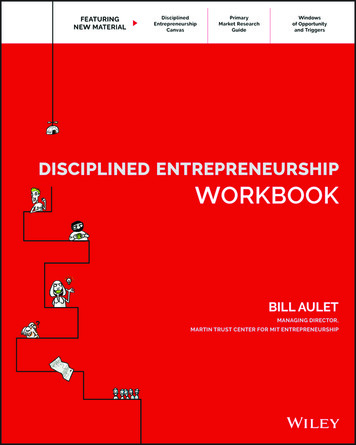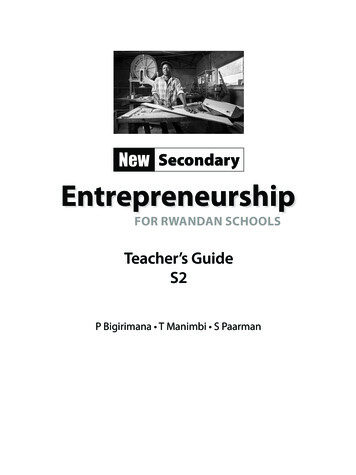
Transcription
SecondaryEntrepreneurshipFOR RWANDAN SCHOOLSTeacher’s GuideS2P Bigirimana T Manimbi S Paarman
ContentsIntroduction . . . . . . . . . . . . . . . . . . . . . . . v1. How to use this Teacher’s Guide. . . . . vSub-topic area: Work in socio-economicdevelopment. . . . . . . . . . . . . . . . . . . . . . 152. How Entrepreneurship meets the needsof the new competency-basedcurriculum vUnit 3 R ole of work and socioeconomic development . . . . . 153.1Content summary. . . . . . . . . . . . . 153. The Scheme of work. . . . . . . . . . . . . . . xi3.2Additional content. . . . . . . . . . . . 154. How to use the sample lesson plan. . . xi3.3Teaching steps. . . . . . . . . . . . . . . . 175. Content map . . . . . . . . . . . . . . . . . . . . xi3.4Marking checklist. . . . . . . . . . . . . 196. The role of Entrepreneurshipin Society . . . . . . . . . . . . . . . . . . . . . xxix3.5Suggested answers. . . . . . . . . . . . . 19Topic area: Entrepreneurial culture1Sub-topic area: Concept ofentrepreneurship . . . . . . . . . . . . . . . . . . . 1Unit 1 Roles, benefits and challengesof an entrepreneur . . . . . . . . . . 11.1Content summary. . . . . . . . . . . . . . 11.2Additional content . . . . . . . . . . . . . 11.3Teaching steps. . . . . . . . . . . . . . . . . 31.4Marking checklist . . . . . . . . . . . . . . 51.5Suggested answers. . . . . . . . . . . . . . 6Sub-topic area: Personal development . . 9Unit 2 Setting personal goals. . . . . . . . 92.1Content summary. . . . . . . . . . . . . . 92.2Additional content . . . . . . . . . . . . . 92.3Teaching steps . . . . . . . . . . . . . . . 112.4Marking checklist . . . . . . . . . . . . . 132.5Suggested answers. . . . . . . . . . . . . 13Topic area: Business activity23Sub-topic area: Concept of businessactivities . . . . . . . . . . . . . . . . . . . . . . . . 23Unit 4 Market. . . . . . . . . . . . . . . . . . . 234.1Content summary. . . . . . . . . . . . . 234.2Additional content. . . . . . . . . . . . 234.3Teaching steps. . . . . . . . . . . . . . . . 254.4Marking checklist. . . . . . . . . . . . . 294.5Suggested answers. . . . . . . . . . . . . 30Sub-topic area: Taxation. . . . . . . . . . . . . 34Unit 5 Taxes in Rwanda. . . . . . . . . . . 345.1Content summary. . . . . . . . . . . . . 345.2Additional content. . . . . . . . . . . . 355.3Teaching steps. . . . . . . . . . . . . . . . 375.4Marking checklist. . . . . . . . . . . . . 415.5Suggested answers. . . . . . . . . . . . . 42
Topic area: Financial information anddecision making 46 Topic area: Business growth andethics Sub-topic area: Managing finances:Budgeting. . . . . . . . . . . . . . . . . . . . . . . . 46Sub-topic area: Standardisation. . . . . . . 6464Unit 6 Personal budgeting. . . . . . . . . 46Unit 8 C oncepts of metrology andquality testing. . . . . . . . . . . . . 646.1Content summary. . . . . . . . . . . . . 468.1Content summary. . . . . . . . . . . . . 646.2Additional content . . . . . . . . . . . . 468.2Additional content. . . . . . . . . . . . 646.3Teaching steps. . . . . . . . . . . . . . . . 488.3Teaching steps. . . . . . . . . . . . . . . . 666.4Marking checklist . . . . . . . . . . . . . 508.4Marking checklist. . . . . . . . . . . . . 686.5Suggested answers. . . . . . . . . . . . . 508.5Suggested answers. . . . . . . . . . . . . 69Sub-topic area: Basic Accounting. . . . . . 53Unit 7 I nitial Accounting entriesof a business . . . . . . . . . . . . . . 537.1Content summary. . . . . . . . . . . . . 537.2Additional content . . . . . . . . . . . . 537.3Teaching steps. . . . . . . . . . . . . . . . 567.4Marking checklist . . . . . . . . . . . . . 597.5Suggested answers. . . . . . . . . . . . . 60Additional resources for teachers71Worksheets 1 to 8. . . . . . . . . . . . . . 71 – 79Memorandum: Worksheets1 to 8. . . . . . . . . . . . . . . . . . . . 80 – 88
INTRODUCTION1. How to use this Teacher’sGuideThis Teacher’s Guide goes with thetextbook for S2 Entrepreneurship. It helpsteachers use Rwanda’s new curriculum.The main purpose of the curriculum is tohelp Rwandans learn the necessarycompetencies (knowledge, skills, valuesand attitudes) to achieve the aims ofVision 2020 and recent governmentpolicies. These policies aim to turnRwanda into a competence-based society,and need a curriculum that includes thebest education practices in the developingworld.Teachers should read the Introductionto this guide to understand how S2Entrepreneurship satisfies the newcompetence-based curriculum. TheIntroduction gives a clear explanation of acompetence-based curriculum, as well ashow to develop these competencies inlearners. It lists the cross-curricular basiccompetencies and describes the genericcompetencies in user-friendly terms. Italso lists and explains the cross-cuttingissues that are built into the curriculum,highlighting the importance of dealingwith these issues with young learners.The new competence-based curriculumrequires a shift in teaching style, andlearning and assessment approaches. TheIntroduction to this Teacher’s Guide alsoclearly explains learner-centred learning,formative and summative assessment,teaching multi-ability learners (includingthose with special educational needs) andclassroom organisation. Schools havedifferent infrastructures and facilities andteachers are taught to work with whatthey have. It includes a detailed Contentmap that gives the key components ofeach learning unit in this course, as well assample lesson plans. Finally, theIntroduction contains a clear explanationof S2 Entrepreneurship and its importanceto learners in Rwanda and in society ingeneral. The broad S2 Entrepreneurshipsyllabus competencies are outlined, as wellas the basic resources and skills requiredfor teaching this subject in the classroom.Following the Introduction, thisTeacher’s Guide contains clear, conciseand user-friendly notes for the teacher tohelp with the implementation of S2Entrepreneurship. Notes are presentedunit‑by‑unit and follow the syllabusclosely. These notes are clear and completeto provide teachers with the support theyneed. Teachers are guided step-by-stepthrough the teaching and learning processfor this subject, and are also encouraged toextend and enrich their learners beyondthe syllabus requirements.2. H ow S2 Entrepreneurshipmeets the needs of the newcompetence-based curriculumThis course aims to meet the needs of thenew competence-based curriculum byproviding a Student’s Book and Teacher’sGuide based on the key components ofthe curriculum.a) What is a competence-basedcurriculum?A competence-based curriculum helps todevelop learners’ knowledge, skills,attitudes and values in a holistic way. Thecurriculum focuses not only on teachingINTRODUCTION v
and learning subject content and skills,but also aims to teach particular attitudesand values, that benefit learners andsociety as a whole. Learning becomesmore than just learning knowledge andskills. It engages learners in experiencesand activities that positively influencetheir understanding and approach towardswhat they are learning.b) How to develop competencies inlearnersA competency is the ability to do a certaintask successfully, because of havingobtained a particular combination ofknowledge, skills, attitudes and values.The national policy documents, which arebased on the ideals of Rwanda as a nation,focus on cross-curricular ‘basiccompetencies’ and cross-curricular ‘genericcompetencies’. Basic competencies relateto: Literacy Numeracy ICT and digital competencies Citizenship and national identity Entrepreneurship and businessdevelopment Science and technology Communication in official language.Generic competencies, on the other hand,are not subject-specific and may beapplied to any subject or situation. Thesecore competencies are: Critical thinking and problem-solvingskills: The ability to think creatively andwidely in order to find solutions toproblems in many different situations. Creativity and innovation: The abilityto take the initiative and to use yourimagination to find new and better waysof doing things. Research: To collect and use informationto ask and answer questions, and toexplain ideas, concepts and phenomena.vi INTRODUCTION Communication skills: To use thelanguage of instruction to communicateeffectively and correctly throughspeaking and writing. Co-operation, interpersonalmanagement and life skills: Toco-operate with others in a team and toshow positive moral values and respectfor the rights, feelings and beliefs ofothers; to take steps to conserve andprotect the environment; to improvepersonal, family and community health,hygiene and nutrition, and to react in apositive way to life’s challenges. Lifelong learning: To continue learningformally and informally throughoutyour life so that you can deal withchanges as you progress through life.c) Cross-cutting issuesThere are eight cross-cutting issues, whichreflect key national concerns and areincluded in the curriculum for all subjectareas. These are: Genocide studies: This is aimed athelping learners to understand what ledto the 1994 genocide and the inspiringstory of healing and rebuilding nationalunity. It is also aimed at encouraginglearners to be aware of the role andresponsibility of each individual toensure that nothing of this nature everhappens again. Environment and sustainability: Thisis aimed at increasing learners’understanding of the impact of humanson the environment and what they cando to protect the environment aroundthem. Learners need to learn aboutsustainability, as well as the skills,attitudes and values to practise andpromote sustainability in their world. Gender: Learners should learn torecognise basic human rights and theimportance of promoting femaleequality. They learn to understand that
preventing the female population fromparticipating fully in society has anegative impact on the development ofthe nation as a whole. A goodunderstanding of gender equality helpsto ensure that the potential of the wholepopulation will be realised in future.Comprehensive sexuality education:This issue deals with topics such as HIV/AIDS, STI, family planning, genderequality and reproductive health. Takingthe age and gender of the learners intoconsideration, it gives learners theappropriate knowledge, skills, valuesand attitudes to make positive choicesabout their sexuality and life style.Many young people have littleknowledge about sexuality and gender,and this can make them vulnerable toabuse, ill health and unplannedpregnancies. Comprehensive sexualityeducation deals with these issues in arespectful and open way, whichemphasises basic human rights.Peace and values education: Peace isnecessary for a society to develop andfor individuals to focus on personalachievement and their contribution tothe nation. Values education helps toensure that young people contributepositively to society through promotingpeace and being committed to avoidingconflict.Financial education: This introduceslearners to good financial practices andbehaviours that ensure their economicwell-being and that of the nation as awhole. It provides them with the toolsfor participating in a healthy economy,which can transform their lives.Standardisation culture: This helpslearners to understand the importanceof standards in economic developmentand sustainability. Accepting astandardisation culture has a positiveimpact on infrastructure,industrialisation, economic growth,trade and the welfare of the nation as awhole. Inclusive education: This means thatall learners must be educated, regardlessof their gender or ability, includingthose with learning difficulties or otherdisabilities. It ensures that all learnersparticipate actively and positively ineducation, and it includes differentlearning styles.d) What is student-centred learning(SCL)?The new curriculum requires a movetowards student-centred learning (SCL)and S2 Entrepreneurship is designed tosupport this move. Learners must beactively involved in their learning, andnot be passive recipients of informationpassed on by the teacher or from atextbook.They learn by taking part in activitiesthat require them to question, discuss, dopractical tasks, solve problems, work in agroup, think critically, use theirimaginations and so on. They constructknowledge for themselves by moving fromthe concrete through the pictorial to theabstract. In this way they develop skills,attitudes and values in addition to contentknowledge.The creation of a learner-friendlyenvironment is based on the abilities,needs, interests and experiences of thelearners themselves. SLC also helpslearners to become more responsible fortheir own learning and to developawareness of their own learning styles. Italso teaches them to think about theirthinking and to understand the learningprocess and how they reach a particularsolution, or decision.INTRODUCTIONvii
The shift to learner-centred or activelearning necessitates a change in teachingstyles. Teachers (and textbooks) are nolonger considered to be the source of allknowledge, as they become facilitators,organisers, advisors, counsellors and rolemodels. For many teachers, who areaccustomed to more traditional ways ofteaching, the change may be difficult.This Teacher’s Guide is designed tosupport and encourage teachers inimplementing SLC in the following ways: Suggestions are given for classroomorganisation, which include whole class,group, pair and individual work,ensuring learners engage with oneanother in activities. Lists of suitable resources and materialsare provided that enable learners toexplore, discover and constructknowledge in different ways. Advice is given on how to elicit andassess prior knowledge on new topics, sothat learners are able to build newunderstandings based on what theyalready know. A range of learning activities is includedthat enables learners to develop andconsolidate new knowledge, skills,values and attitudes in different ways,taking into account that learners learnin different ways and progress atdifferent rates. Assessment procedures are clearlyoutlined to determine the effectivenessof teaching and learning processes. Helpful questions and answers areprovided that enable teachers toevaluate learning and to offerappropriate remediation, consolidationand enrichment to learners.Not only does this Teacher’s Guidesupport teachers in creating a suitablelearner-friendly environment to encouragelearning both in and out of the classroom,viii INTRODUCTIONbut it also supports the development ofteachers themselves in their newprofessional roles.e) Assessment requirementsAssessment plays a crucial role in a learnercentred, competence-based curriculum andit presents new challenges for the teacher.Since the focus is now on how the learneris able to apply knowledge, skills, valuesand attitudes in different contexts, thenature of assessment has changed both interms of what to assess and how to assess.The curriculum emphasises two types ofassessment, namely Formative orContinuous assessment (assessment forlearning) and Summative assessment(assessment of learning). These two typesof assessment are explained in more detailbelow.Formative assessment (assessment forlearning)Formative or continuous assessment maybe formal or informal and it is used tocheck if learning is actually occurring.Before each learning unit, the teacher hasto identify assessment criteria andprocedures for evaluating learners againstthese criteria. Then, at the end of eachlearning unit, the teacher has to ensurethat every learner has mastered the keyunit competencies before progressing tothe next unit. The teacher has to assesshow well each learner has mastered boththe subject and generic competenciesdescribed in the syllabus and, from this,will be able to assess the learner’sall-round progress.This Teacher’s Guide provides clearadvice and guidelines to teachers forformative assessment in every learningunit. Key unit competencies, assessmentcriteria and learning objectives aresignposted at the start of every unit, andadvice is given on what and how to assess
learners at the end of every unit. Inaddition, suggestions are provided forassessing learners’ prior knowledge orexperience at the start of a learning unit,and for assessing the learning processduring the unit. A variety of formativeassessment methods are suggested,including observation, oral questioning,peer and self-assessment, pen and paper,and so on. This Teacher’s Guide alsofocuses on involving the learners in theformative assessment process, so that theybecome more aware of and responsible fortheir own learning.Summative assessment (assessment oflearning)Summative assessment is used to assessthe learners’ competence at the end of aprocess of learning. Typically, it is used toassess whether learning objectives havebeen achieved and the results may be usedto rank or grade learners, to decide onprogression, to select for the next level ofeducation, or for certification. Summativeassessment needs to be integrative in orderto show that the learner has mastered allthe competencies. Thus, assessment tasksrequire learners to apply their knowledge,skills, values and attitudes in differentcontexts. Summative assessment usuallyoccurs at the end of a learning unit, at theend of a school term and at the end of aschool year.As with formative assessment, thisTeacher’s Guide provides clear guidelinesto teachers for implementing summativeassessment at the end of every learningunit. Practical advice is given on what toassess, how to assess and how to awardmarks or score via simple rubrics, answermemos, checklists and so on. These aredesigned to assist teachers with assessinglearners’ competencies in an integrativeway, and with making decisions aboutprogression to the next unit or level.f) Teaching multi-ability learnersAll learners have the right to learn,regardless of their different needs orabilities whether these are physical,emotional, social or intellectual. ThisTeacher’s Guide has a section in everylearning unit which is aimed at assistingthe teacher with providing for learnerswith different needs and abilities. Theseinclude those who require remediation,consolidation, and e extension work.Each subsection is clearly signpostedand typically includes questions (withpossible answers) that can be posed toeach group in order to facilitate theirlearning. In addition, careful thought hasbeen given to the resources and materialslisted for every learning unit, so that theneeds of different learners may be met.g) Catering for SEN learnersTeaching multi-ability learners includesproviding for those with specialeducational needs (SEN). Inclusiveeducation involves the provision oflearning materials and activities thatenable those with physical, emotional,social or intellectual difficulties to activelyengage in and fully benefit from thelearning process. SEN‑learners must feelacknowledged and as much a part of theteaching and learning environment, asthose without these particular needs. S2Entrepreneurship reflects positive imagesof the active inclusion of disabled peoplein its texts, illustrations and activities.Suggestions are also given to teachers inthe unit notes of this Teacher’s Guide toemphasise this message wheneverpossible, both in the classroom andoutside of it.h) Gender representationJust as learners with SEN difficulties areshown in a positive way and are involvedas active participants in this course, so areINTRODUCTION ix
females. Any kind of gender stereotypingis avoided in this course material andevery effort has been made to demonstrategender equality in the home, at school, inthe work place, and in all other aspects ofsociety. Where necessary, notes have beenincluded in this Teacher’s Guide to remindand encourage teachers to emphasise theimportant message of gender equality, andto treat this issue with the respect itdeserves.i) Different infrastructure andfacilitiesIn Rwanda and other countries in Africa,schools differ in respect of theirinfrastructures, facilities, resources andconditions. This is especially true in thedifference between urban and ruralschools. Teachers should not give in to thetemptation to ignore the requirements ofthe competence-based curriculum andfocus only on teaching syllabus content.S2 Entrepreneurship is designed toenable all schools and learners in Rwandato learn the required competencies. Ittakes into account basic levels of resourceprovision and clearly states the minimumlevel of work needed for all schools andlearners to meet the curriculumrequirements. It also takes into accounthigher levels of resource provision anduses a ‘layered approach’ to learningactivities that provide for schools with orwithout a computer lab, science lab,library, internet connectivity and so on.Teaching notes may consist of alternativesuggestions, depending on the resourcesavailable at a particular school. Forexample, they may state:If your learners have access to the internet,then If your learners do not have access to theinternet, then x INTRODUCTIONJ) Classroom organisationClassroom organisation has to change toencourage the learner-centred learningdemanded by the curriculum.S2 Entrepreneurship explains theorganisation of the classroom as anactivity-based, learner-centredenvironment. Different ways of organisingthe classroom are suggested andencouraged including whole class, largeand small group, paired and individualactivities. As group work and pair workmay be unfamiliar, and fill teachers andlearners with uncertainty, it is worthspending time at the start of the course toagree on some rules about this type ofinteractive learning. It is also advisable forteachers to introduce paired and groupwork activities gradually until they (andlearners) become more familiar with it.Suggestions for implementing paired andgroup work activities include: Deciding on a signal that your classunderstands means the start or end ofpair or group work (for example, raisingyour hand, ringing a little bell, writing aparticular symbol on the board). Having each learner turn to the personnext to/behind/in front of them for pairwork, in order to avoid too muchmovement around the classroom. Having each pair join up with the pairnext to/behind/in front of them forsmall group work. Numbering learners from 1–8 and thenasking all the ones to form a largegroup, all the twos to form another largegroup, and so on. Having a few basic rules for listeningand speaking in a pair or group (such astaking turns, making sure everyone hasa chance to say something, usingappropriate body language, learning afew terms to express agreement ordisagreement politely).
Giving different roles to differentmembers of each group (such assomeone who writes down everyone’sideas, someone else who reports backeveryone’s ideas to the rest of the class,someone who makes sure everyonecontributes to the discussion, andsomeone who collects all the materialsfor the group). Pairing or grouping learners accordingto their abilities so that they are able toprogress at their own pace and benefitfrom remediation activities (weakerlearners) or extension activities (strongerlearners). Mixing learners into multi-ability pairsor groups so that weaker learners canbenefit from the input of strongerlearners, and vice versa.Note: Encourage learners to practiceentrepreneurship activities in theircommunities (at school and at home).This is the best indicator ofentrepreneurial activities as a result ofstudying entrepreneurship as a subject atschool.3. The Scheme of workIn addition to helpful notes for eachlearning unit, S2 Entrepreneurship alsocontains a Scheme of work in the Teacher’sGuide and a Learning overview in thetextbook. The Scheme of work provides aclear and easy reference on the following foreach learning unit: Dates and number of lessons (andhomework) in a week The units and key unit competencescovered Subject covered in the lesson Learning objective covered in eachlesson Teaching methods and techniques toapply Resources and references needed foreach lesson Evaluation procedures.4. H ow to use the sample lessonplansThis Teacher’s Guide contains completenotes for the teacher on each learning unitin S2 Entrepreneurship. Within the notesfor each learning unit, there are clear andconcise lesson plans. Lesson planning isnecessary to ensure that all learningobjectives in each unit are covered.Comprehensive support is provided sothat all the knowledge, skills, attitudesand values that are needed are met overtime through a variety of learningactivities and experiences. The lessonplans are simple, direct and user-friendly.Below are two sample lesson plans, whichshow the kind of useful information thatthese plans provide for teachers of thiscourse.5. Content mapIn addition to helpful notes for eachlearning unit, S2 Entrepreneurship alsocontains a Content map in the Teacher’sGuide and a Learning overview in thetextbook. The Content map provides aclear and easy reference on the followingfor each learning unit: Number of lessons (and homework) Introductory activity (for example, aclass discussion on a particular topic) Classroom organisation (whole class,groups, pairs and individual work) Equipment required (list of resourcesand materials required) Learning activities (list of learningactivities as per the syllabus) Competencies practised (broad subjectcompetences and generic competencies) Subject practice (content of particularsubject)INTRODUCTION xi
Vocabulary acquisition (list of key newwords) Study skills Revision Assessments (informal and formalformative and summative assessments) Learning outcomes (list of learningobjectives as per the syllabus).xii INTRODUCTION
INTRODUCTIONxiiiLesson 1:The role ofentrepreneursin thecommunityUnit 1: Roles,benefits andchallengesof anentrepreneurFromFeb 06(Monday)to Feb 10(Friday)2 periods perweekLesson 2:The role ofentrepreneurssocioeconomicdevelopmentLesson title EvaluationUnit titleAttitudes and values: Appreciate the roleof an entrepreneurin socio-economicdevelopment.Skills: Assess the role ofan entrepreneurin socio-economicdevelopment.Knowledge andunderstanding: Recognise the roleof an entrepreneurin socio-economicdevelopment.Learning objectives Key unit competenceTerm: 1 Teacher’s name: DatesAcademic year: 2017 .Subject: Entrepreneurship .S2 Format of Unit Plan/Scheme of workTeaching methods &techniques Evaluation procedures Refer to thevocabularyintroduced insenior 1 and revisitthe definitionsfor entrepreneur,entrepreneurship,enterprising personand intrapreneur. Recap thecharacteristics of anentrepreneur coveredin senior 1. Group work for oral/written feedback(teacher to moveamong the groups tolisten and comment) In pairs, learnerstypically work withthe person sittingnext to them Individual, activitiesassigned forhomework aretypically individual. Reading and EntrepreneurshipSenior 1 and 2Student Books Work ReadinessProgram Trainermanual Internet Case study scenariosResources &ReferencesObservationsSchool: Martyrs Sec School Paul Bigirimana .Class Combination:
xiv INTRODUCTIONDatesUnit titleLesson 3:Entrepreneurs’contributionto socialeconomicdevelopmentLesson title EvaluationLearning objectives Key unit competenceTeaching methods &techniques Evaluation procedures Writing activities areuseful for assessingthe personalunderstanding of thework. Presentations to bedone in small groups,allow a representativefrom each group topresent their work Group work, arrangethe tables in theclassroom so thata smaller group ofbetween four to sixlearners can worktogether. Oftenfeedback is given bya representative tothe whole class eitherorally or by writingon the board. Role-play, dividethe learners intosmall groups of 3or 4. Move amongthem to answer anyproblems. EntrepreneurshipSenior 1 and 2Student Books Work ReadinessProgram Trainermanual Internet Case study scenariosResources &ReferencesObservations
INTRODUCTIONxvUnit 1 Roles, Lesson 4:benefits and Benefits andchallengeschallengesof anentrepreneurFromFebruary 13(Monday) toFebruary 17(Friday)2 periods perweekLesson title EvaluationUnit titleDatesAttitudes and values: Develop apositive attitudetowards being anentrepreneur. Start entrepreneurialactivities in thecommunity.Skills: Analyse the benefitsand challengesassociated with beingan entrepreneur.Knowledge andunderstanding: Describe the benefitsand challengesof being anentrepreneur. Identify the benefitsand challengesof being anentrepreneur.Learning objectives Key unit competenceTeaching methods &techniques Evaluation procedures Presentation of roleplays, ensure thelearners are watchingquietly and beingsupportive of oneanother EntrepreneurshipSenior 1 and 2Student Books Work ReadinessProgram Trainermanual Internet Case study scenariosResources &ReferencesObservations
xvi INTRODUCTIONDatesUnit titleLesson 6:EntrepreneurinterviewLesson 5:Risks andbenefits ofentrepreneursandemployeesLesson title EvaluationLearning objectives Key unit competenceTeaching methods &techniques Evaluation procedures Individual work,can be done ashomework B
general . The broad S2 Entrepreneurship syllabus competencies are outlined, as well as the basic resources and skills required for teaching this subject in the classroom . Following the Introduction, this Teacher’s Guide contains clear, concise and user-friendly notes for the teacher to help with the
